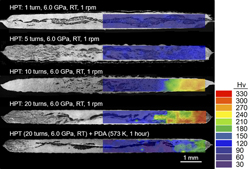Crossref Citations
This article has been cited by the following publications. This list is generated based on data provided by
Crossref.
Figueiredo, Roberto B.
and
Langdon, Terence G.
2019.
Processing Magnesium and Its Alloys by High‐Pressure Torsion: An Overview.
Advanced Engineering Materials,
Vol. 21,
Issue. 1,
Rogachev, S.O.
Khatkevich, V.M.
Nikulin, S.A.
Ignateva, M.V.
and
Gromov, A.A.
2019.
High thermally stable multi-layer steel/vanadium alloy hybrid material obtained by high-pressure torsion.
Materials Letters,
Vol. 255,
Issue. ,
p.
126527.
Han, Jae-Kyung
Jang, Jae-il
Langdon, Terence G.
and
Kawasaki, Megumi
2019.
Bulk-State Reactions and Improving the Mechanical Properties of Metals through High-Pressure Torsion.
MATERIALS TRANSACTIONS,
Vol. 60,
Issue. 7,
p.
1131.
Hernández-Escobar, David
Rahman, Zia Ur
Yilmazer, Hakan
Kawasaki, Megumi
and
Boehlert, Carl J.
2019.
Microstructural evolution and intermetallic formation in Zn-Mg hybrids processed by High-Pressure Torsion.
Philosophical Magazine,
Vol. 99,
Issue. 5,
p.
557.
Han, Jae-Kyung
Liss, Klaus-Dieter
Langdon, Terence G.
and
Kawasaki, Megumi
2019.
Synthesis of a bulk nanostructured metastable Al alloy with extreme supersaturation of Mg.
Scientific Reports,
Vol. 9,
Issue. 1,
Pereira, Pedro Henrique R.
and
Figueiredo, Roberto B.
2019.
Finite Element Modelling of High-Pressure Torsion: An Overview.
MATERIALS TRANSACTIONS,
Vol. 60,
Issue. 7,
p.
1139.
Kawasaki, Megumi
Jung, Seon Ho
Park, Jeong-Min
Lee, Jongsup
Jang, Jae-il
and
Han, Jae-Kyung
2020.
Mechanical Bonding of Aluminum Hybrid Alloy Systems through High‐Pressure Torsion.
Advanced Engineering Materials,
Vol. 22,
Issue. 1,
Han, Jae-Kyung
Park, Jeong-Min
Ruan, Wei
Carpenter, Kevin T.
Tabei, Ali
Jang, Jae-il
and
Kawasaki, Megumi
2020.
Size Effect on Microstructural Evolution and Micromechanical Responses of Mechanically Bonded Aluminum and Magnesium by High‐Pressure Torsion.
Advanced Engineering Materials,
Vol. 22,
Issue. 10,
Rogachev, Stanislav O.
Nikulin, Sergey A.
Khatkevich, Vladimir M.
Sundeev, Roman V.
and
Komissarov, Alexander A.
2020.
Features of Structure Formation in Layered Metallic Materials Processed by High Pressure Torsion.
Metallurgical and Materials Transactions A,
Vol. 51,
Issue. 4,
p.
1781.
Korznikova, Galiia
Kabirov, Rinat
Nazarov, Konstantin
Khisamov, Rinat
Shayakhmetov, Ruslan
Korznikova, Elena
Khalikova, Gulnara
and
Mulyukov, Radik
2020.
Influence of Constrained High-Pressure Torsion on Microstructure and Mechanical Properties of an Aluminum-Based Metal Matrix Composite.
JOM,
Vol. 72,
Issue. 8,
p.
2898.
Han, Jae-Kyung
Herndon, Taylor
Jang, Jae-il
Langdon, Terence G.
and
Kawasaki, Megumi
2020.
Synthesis of Hybrid Nanocrystalline Alloys by Mechanical Bonding through High‐Pressure Torsion.
Advanced Engineering Materials,
Vol. 22,
Issue. 4,
Mulyukov, R R
Nazarov, K S
Shayakhmetov, R U
Korznikova, G F
and
Korznikova, E A
2020.
Nano-mechanical testing of Al-Nb metal matrix composites consolidated by high pressure torsion after annealing.
IOP Conference Series: Materials Science and Engineering,
Vol. 1008,
Issue. 1,
p.
012002.
Han, Jae-Kyung
Liss, Klaus-Dieter
Langdon, Terence G.
Jang, Jae-il
and
Kawasaki, Megumi
2020.
Mechanical properties and structural stability of a bulk nanostructured metastable aluminum-magnesium system.
Materials Science and Engineering: A,
Vol. 796,
Issue. ,
p.
140050.
Pesin, Alexander
Pustovoitov, Denis
Biryukova, Olesya
and
Ilyina, Natalia
2020.
FEM simulation of fabrication of Al-steel layered composites with mechanical bonding through the interfacial concavo-convex lock effect.
Procedia Manufacturing,
Vol. 50,
Issue. ,
p.
579.
Bazarnik, Piotr
Bartkowska, Aleksandra
Romelczyk-Baishya, Barbara
Adamczyk-Cieślak, Bogusława
Dai, Jiaoyan
Huang, Yi
Lewandowska, Małgorzata
and
Langdon, Terence G.
2020.
Superior strength of tri-layered Al–Cu–Al nano-composites processed by high-pressure torsion.
Journal of Alloys and Compounds,
Vol. 846,
Issue. ,
p.
156380.
Beygelzimer, Yan
Estrin, Yuri
Mazilkin, Andrey
Scherer, Torsten
Baretzky, Brigitte
Hahn, Horst
and
Kulagin, Roman
2021.
Quantifying solid-state mechanical mixing by high-pressure torsion.
Journal of Alloys and Compounds,
Vol. 878,
Issue. ,
p.
160419.
Castro, Moara M.
Montoro, Luciano A.
Isaac, Augusta
Kawasaki, Megumi
and
Figueiredo, Roberto B.
2021.
Mechanical mixing of Mg and Zn using high-pressure torsion.
Journal of Alloys and Compounds,
Vol. 869,
Issue. ,
p.
159302.
Mulyukov, R. R.
Korznikova, G. F.
Nazarov, K. S.
Khisamov, R. Kh.
Sergeev, S. N.
Shayachmetov, R. U.
Khalikova, G. R.
and
Korznikova, E. A.
2021.
Annealing-induced phase transformations and hardness evolution in Al–Cu–Al composites obtained by high-pressure torsion.
Acta Mechanica,
Vol. 232,
Issue. 5,
p.
1815.
Taheriniya, Shabnam
Davani, Farnaz A.
Hilke, Sven
Hepp, Marco
Gadelmeier, Christian
Chellali, Mohammed Reda
Boll, Torben
Rösner, Harald
Peterlechner, Martin
Gammer, Christoph
Divinski, Sergiy V.
Butz, Benjamin
Glatzel, Uwe
Hahn, Horst
and
Wilde, Gerhard
2021.
High entropy alloy nanocomposites produced by high pressure torsion.
Acta Materialia,
Vol. 208,
Issue. ,
p.
116714.
Sánchez, Carlos A.
Cardona-Maya, Yamile
Morales, Andrés D.
Rudas, Juan S.
and
Isaza, Cesar A.
2021.
Development and evaluation of polyvinyl alcohol films reinforced with carbon nanotubes and alumina for manufacturing hybrid metal matrix composites by the sandwich technique.
AIMS Materials Science,
Vol. 8,
Issue. 2,
p.
149.





